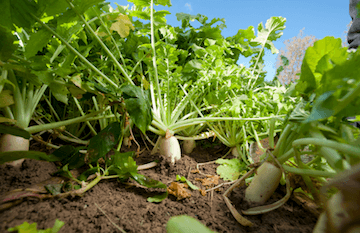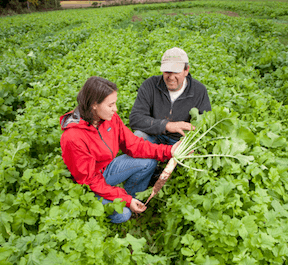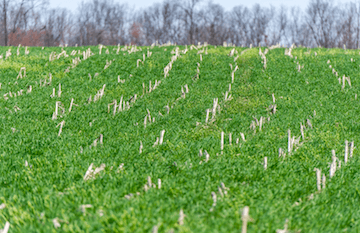Cover Crop Mixes

Cover Crop Varieties
Cereal Ryegrass
Sorghum / Sudan Grass
Berseem Clover
White Mustard
White and Hybrid Pearl Millet
Buckwheat
Persian Clover / Berseem Clover
Cow Peas / Soybean
Kale
Fava Bean
Crimson Clover
Dutch White Clover
Hairy Vetch
White Sweet Clover
Ladino Clover
Oats / Flax
Sunflower
Sunn Hemp
Triticale
Turnip /Daikon Radish

Benefits of Cover Crops
Cover Crops are plants that are used primarily to help improve soil that has been depleted or eroded. Their many benefits include:
Prevent Erosion
Bare earth is something to be avoided; ground that is exposed to the elements is at a greater risk of erosion by the wind and water runoff. Cover crops help to stabilize the soil, prevent runoff erosion and bind the soil together.
Improve Soil Structure
The roots of the cover crop create passages and pore spaces that allow for moisture percolation and aeration of the soil, along with providing space for insects and other microorganisms to move through it.
Organic Matter
Soil is improved by the addition of organic matter in the form of leaves dropping to the ground or when rolled and crimped to form a natural mulch or compost.
Suppress Weeds
The roots of the cover crops compete vigorously with weeds for available nutrients, depriving the weeds of the elements they need to thrive. The leaves of the cover crops also compete for light and space above ground, typically shading out the weeds so that they cannot photosynthesize effectively.
Moisture
Planting a cover crop is an effective way to conserve and even increase the moisture content of the soil. Besides preventing runoff by limiting the erosion of the topsoil, the crops provide a cover for the soil. Also, many cover crops send down deep roots, which can bring up moisture from lower levels in the

More Benefits
Nutrients
Cover crops also bring to the soil valuable nutrients, such as nitrogen. Members of the legume family of plants have a special ability to ‘fix’ nitrogen in the soil. They have nodules on their roots that provide a habitat for certain nitrogen-fixing bacteria. Not only does this increase levels of nitrogen in the soil while the plant is growing, when the plant dies back, after harvesting, for example, the nitrogen is released into the soil and becomes available to other plants. Examples of leguminous cover crops include vetch, field peas and clover.
Less Work
Cover crops also save time and energy. Given all the nutrients that they provide to the soil. Cover crops are a good option when looking to improve the soil quality of a large area and by suppressing weeds, it reduces the need to sheet mulch an area.
Produce
. Certain species of cover crops can provide an edible harvest. Legumes such as peas and beans perform both functions, while mustard plants and daikon are also suitable cover crops that you can eat.
Biodiversity
Cover crops add to the biodiversity and can attract beneficial insects, or repel insects that could damage neighboring specimens.
Insects
This biodiversity is a major part of attracting a wide variety of insects. By planting cover crops rather than leaving bare earth, you will bring more species of insects, some which may prey on others and so prevent populations booming which may impact upon your crop yield. Attracting insects also increases the number of pollinators on your site, helping propagate your garden plants.
